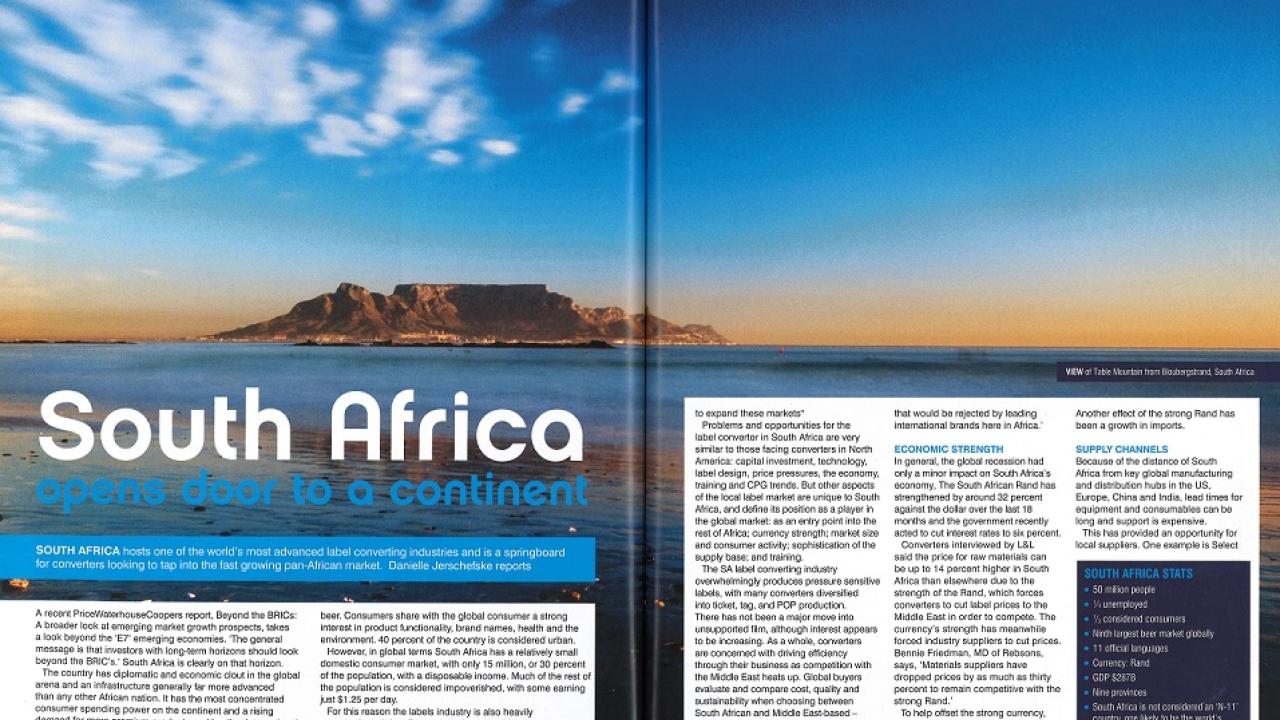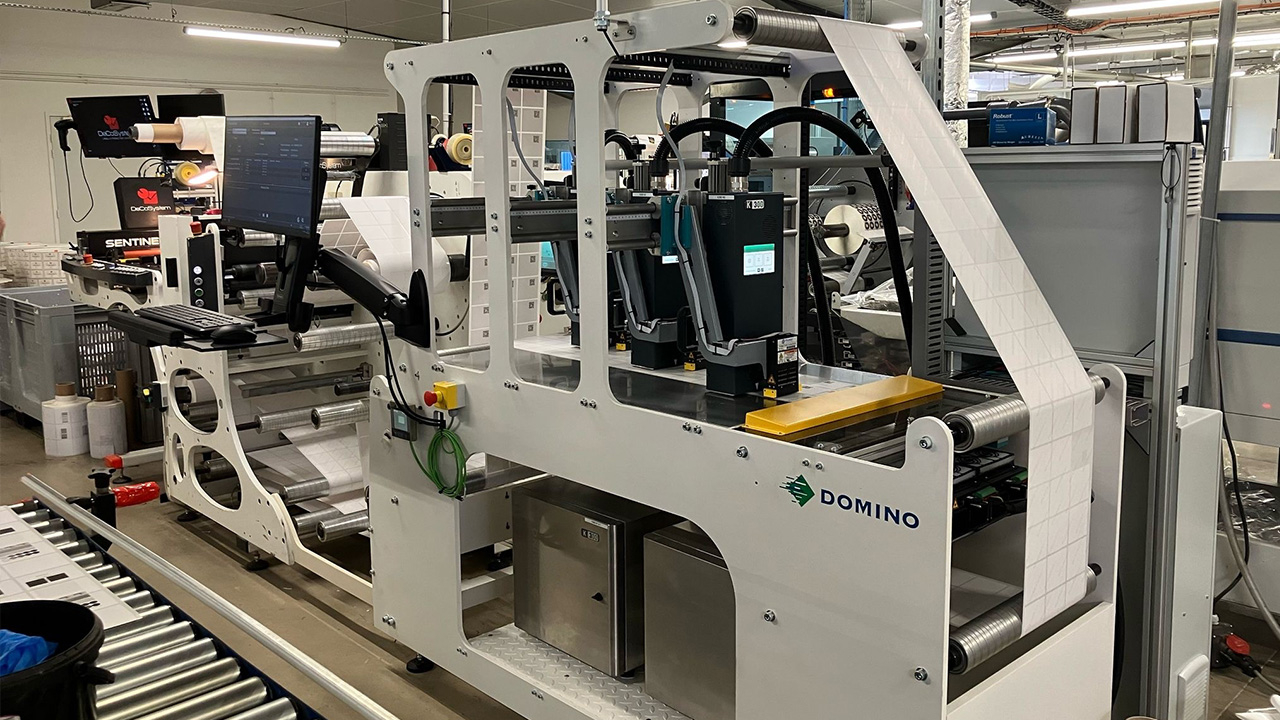L&L turns 40: South Africa opens door to a continent

A recent PriceWaterhouseCoopers report, ‘Beyond the BRICs: A broader look at emerging market growth prospects’, takes a look beyond the ‘E7’ emerging economies. ‘The general message is that investors with long-term horizons should look beyond the BRIC’s.’ South Africa is clearly on that horizon.
The country has diplomatic and economic clout in the global arena and an infrastructure generally far more advanced than any other African nation. It has the most concentrated consumer spending power on the continent and a rising demand for more premium products and leading international brands, all pointing towards quality labels and packaging competing for shelf space.
For example, nearly everyone has a cell phone and all the cell phone companies have operations here. Even in the outer townships, there’s a local store selling Vodacom calling cards, Coca-Cola and 750ml bottles of Carling Black Label beer. Consumers share with the global consumer a strong interest in product functionality, brand names, health and the environment. 40 percent of the country is considered urban.
However, in global terms South Africa has a relatively small domestic consumer market, with only 15 million, or 30 percent of the population, with a disposable income. Much of the rest of the population is considered impoverished, with some earning just $1.25 per day.
For this reason the labels industry is also heavily export-oriented. Lee Barnard, co-founder of label converter Track & Trace, says, 'I am confident of growth in the label industry in our country as well as the rest of Africa. We manufacture labels for the export fruit industry, predominately to Europe and the UK, which has shown consistent growth.
‘Using a network of distributors we have also started to sell our products into Sub Sahara and Mid Africa and see opportunity to expand these markets.’
Problems and opportunities for the label converter in South Africa are very similar to those facing converters in North America: capital investment, technology, label design, price pressures, the economy, training and CPG trends. But other aspects of the local label market are unique to South Africa, and define its position as a player in the global market: as an entry point into the rest of Africa; currency strength; market size and consumer activity; sophistication of the supply base; and training.
The SA label converting industry overwhelmingly produces pressure sensitive labels, with many converters diversified into ticket, tag, and POP production. There has not been a major move into unsupported film, although interest appears to be increasing. As a whole, converters are concerned with driving efficiency through their business as competition with the Middle East heats up. Global buyers evaluate and compare cost, quality and sustainability when choosing between South African and Middle East-based – particularly Egypt – converters.
Label converters working with international CPGs stress the focus on quality in South Africa - the popular term is ‘pedantic’. Bharat Mehta, MD Uniprint, says, ‘Quality in the US is not there. I’ve seen labels on the store shelves there that would be rejected by leading international brands here in Africa.’
Economic strength
In general, the global recession had only a minor impact on South Africa’s economy, The South African Rand has strengthened by around 32 percent against the dollar over the last 18 months and the government recently acted to cut interest rates to six percent.
Converters interviewed by L&L said the price for raw materials can be up to 14 percent higher in South Africa than elsewhere due to the strength of the Rand, which forces converters to cut label prices to the Middle East in order to compete. The currency’s strength has meanwhile forced industry suppliers to cut prices. Bennie Friedman, MD of Rebsons, says, ‘Materials suppliers have dropped prices by as much as thirty percent to remain competitive with the strong Rand.’
To help offset the strong currency, converters are increasingly offering to store inventory for their customers, especially for smaller companies. At the same time, buyers are driving down stockholding and becoming more conscious of inventory, on-demand delivery and cash flow. Another effect of the strong Rand has been a growth in imports.
Supply channels
Because of the distance of South Africa from key global manufacturing and distribution hubs in the US, Europe, China and India, lead times for equipment and consumables can be long and support is expensive. This has provided an opportunity for local suppliers. One example is Select Inks, whose owner, Peter Thomas, is well known for his technical competence, support network and innovation.
Other converters, including Rebsons and Track & Trace, utilize local MIS supplier Systec. Rebson’s Friedman says, ‘It’s nice that they’re local. We don’t have to deal with the complications of a company from outside the market.’ Rebsons is about to implement a full barcode-driven production monitoring system.
Local company Lieben Dies manufactures punching tools and dies for cut & stack and in-mold labels. ‘The South African market and the African market in general has enormous potential,’ says the company’s Flip Liebenberg. ‘Converters here have state-of-the art production plants in a market that’s considered emerging.’
First Impression Labels expressed some difficulty in sourcing wraparound laminate materials. PET is most frequently imported from the East, and is in short supply. MD Sandra Cumming says, ‘The huge PET shortage makes it difficult to find supply. There can be as much as a three month lead time in order to receive materials and as much as a six week forecast for PET.’
Global companies, meanwhile, continue to use their global supply chains. Spear, for example, partners with Avery Dennison globally and uses the same Siegwerk inks specified by its Tennessee, US operation.
Training
Although there are no national benchmarks for skill certification in South Africa, a range of educational tools are available.
Converter HP Labelling supports the apprenticeship program provided by SA’s Media Advertising Publishing Printing Packaging sector education training authority (MAPP seta).
‘It’s so important to prepare and support operators in South Africa,’ says the company’s Neville Gibbs. ‘The program is based on a modular system with a focus on both theoretical and practical. When an individual finishes the program they graduate as a senior printer with a certificate for verification.’ In a final test, the student is required to set up and run a job in registration. The converter has taken in four people on the apprenticeship program.
Paarl Labels, together with its sister companies, has established the ‘Academy of Print’, based in Paarl. It is fully accredited by the MAPP SETA.
For 18 years Ferroprint has used a self-designed 14 module training program for the development of its employees. At any time, an employee can elect to learn a module, earning certifications for that specific job task. Additionally the converter sends up to four people annually to its suppliers for training updates. Upon return, the new information is systematically filtered back through the rest of the associates. The company also hosts a day where suppliers come into the plant to conduct training.
Both Lithotech Labels and RotoLabel have access to centralized training provided by parent company Bidvest. Kevin Swan, MD at Lithotech says, ‘We understand the value of spending money on training. We have our own training center where all employees are educated and tested on the basics of printing litho, gravure and flexo printing.’ Rotolabel also has a MAPPP SETA approved Learnership Program. Greg Gabriels runs the training program and Rotolabel boasts 28 learners in various stages of completion.
Sustainability
All the big brands have sustainability programs in SA – Unilever, Woolworth’s, SABMiller being key examples – and more label and packaging converters are being proactive in reducing their business’ environmental footprint. Energy consumption is of particularly high importance in South Africa.
A new Waste Management Act came into effect in 2009 making producer responsibility a legal requirement. The Packaging Council of South Africa is working on a paper and packaging industry waste management plan.
A report undertaken by label converter Clomark with 40 regional FMCG companies, found that 26 percent of respondents were prepared to pay a five to ten percent premium for ‘eco-labels’. Of that group, 60 percent rated eco-labels as a ‘medium importance’ issue on a scale of one to five.
When asked about ‘eco-packaging’, 50 percent of respondents ranked it as ‘intermediately’ important, while forty percent said that eco-packaging is of ‘high’ importance. The study also found that CO2 emission data influences the purchasing decision of over half of respondents.
Uniprint’s Bharat Mehta confirms the trend. ‘As a large printer for Coca-Cola, we have a sustainability measure to meet in order to remain as a selected supplier.’ Uniprint recycles as much as it can, including the film left over from plate production. Already ISO 9002:2008 certified, the company is contemplating ISO 14000 certification.
BidVest Group, owner of Rotolabel and Lithotech, is one of the few SA companies listed on the Dow Jones Sustainability World Index, as well as receiving an ‘excellent’ rating in the Ernst & Young Excellence in Sustainability Reporting award. The company created an environmental policy in 2008, appointing an employee-led sustainability committee whose initiatives have included carbon offset programs and low energy lighting systems.
Another company which has been proactive in the sustainability arena is Paarl Labels, which recently launched a treefree label paper, endorsed by a certification seal. The treefree papers are sourced from a Sustainable source, and carry a price tag about the same as for other premium materials. Approved by the South African Wine and Spirit Board, the label paper is made from sugarcane fibre, a by-product of sugar refining, and was developed by Paarl Labels together with UPM Raflatac.
Callie De Wet, MD Paarl Labels, says the company’s marketing campaign has gained rapid, positive feedback. ‘Typically there’s a five percent response to marketing emails, but from this treefree campaign we’ve received a 40 percent response.’ The print quality is basically the same as other standard wine label materials and it performs well in an ice bucket, says de Wet.
Digital
Like all markets in the world, South Africa has seen an increase in digital press installations. Rotolabel has followed its initial investment in an HP Indigo WS4050 to produce short runs for all its customers with two HP Indigo WS6000s. Jessica Rohman, commercial manager at Rotolabel, says, ‘We were doing longer and longer runs on the WS4050 and needed a machine with faster speeds and wider window to increase the throughput required for more efficient work production.’ Rotolabel achieved the third highest output/impressions in the EMEA (Europe, Middle East and Asia) region with it's HP WS4050 in October 2010. It uses an ABG Digicon Series I to coat material and Series II with one screen head, two flexo heads, and foiling to convert.
Private labels
The private label market presents a lot of potential business for label converters in South Africa. Private label brands in the market include Woolworth’s and Massmart, soon to be owned by Walmart. These opportunities shine particularly brightly for converters like Uniprint, under the media giant Avusa’s umbrella, which currently does little private label work.
*This article was first published in Labels & Labeling issue 2, 2011
Follow Labels & Labeling on Twitter, LinkedIn and Instagram, then share your memories of the magazine using #LnLturns40
Find out how to join in with Labels & Labeling’s 40th anniversary celebrations here
Stay up to date
Subscribe to the free Label News newsletter and receive the latest content every week. We'll never share your email address.


